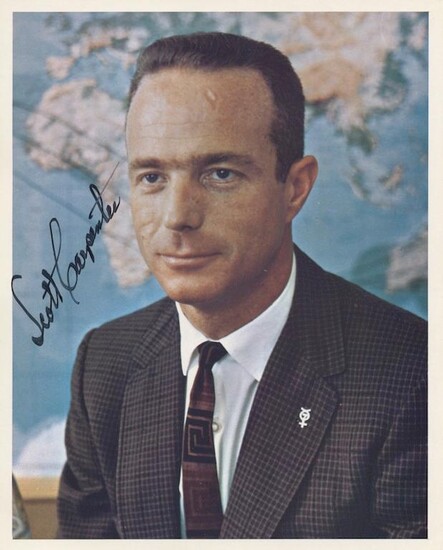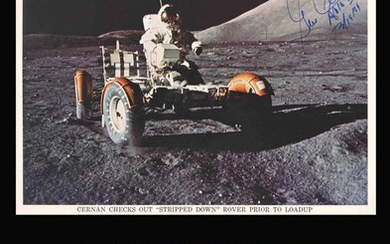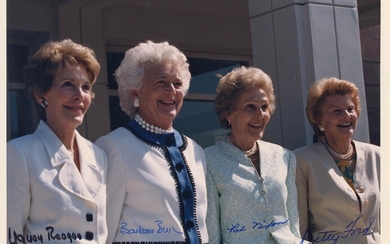PHOTOGRAPH ***Signed***
By Carpenter, Scott
Signed "Scott Carpenter" 8" X 10" color photograph in black ink. Scott Carpenter, a dynamic pioneer of modern exploration, has the unique distinction of being the only human ever to penetrate both inner and outer space, thereby acquiring the dual title, Astronaut/Aquanaut. He was born in Boulder, Colorado, on May 1, 1925, the son of research chemist Dr. M. Scott Carpenter and Florence Kelso Noxon Carpenter. He attended the University of Colorado from 1945 to 1949 and received a bachelor of science degree in Aeronautical Engineering. Carpenter was commissioned in the U.S. Navy in 1949. He was given flight training at Pensacola, Florida and Corpus Christi, Texas and designated a Naval Aviator in April, 1951. During the Korean War he served with patrol Squadron SIX, flying anti-submarine, ship surveillance, and aerial mining missions in the Yellow Sea, South China Sea, and the Formosa Straits. He attended the Navy Test Pilot School at Patuxent River, Maryland, in 1954 and subsequently was assigned to the Electronics Test Division of the Naval Air Test Center. In the assignment he flew tests in every type of naval aircraft including multi and single-engine jet and propeller-driven fighters, attack planes, patrol bombers, transports, and seaplanes. From 1957 to1959 he attended the Navy General Line School and the Navy Air Intelligence School and was then assigned as Air Intelligence Officer to the Aircraft Carrier, USS Hornet. Carpenter was selected as one of the original seven Mercury Astronauts on April 9, 1959. He underwent intensive training with the National Aeronautics and Space Administration (NASA), specializing in the fields of communication and navigation. He served as backup pilot for John Glenn during the preparation for America's first manned orbital space flight. Carpenter flew the second American manned orbital flight on May 24, 1962. He piloted his Aurora 7 spacecraft through three revolutions of the earth, reaching a maximum altitude of 164 miles. The spacecraft landed in the Atlantic Ocean about 1000 miles southeast of Cape Canaveral after 4 hours and 54 minutes of flight time. On leave of absence from NASA, Carpenter participated in the Navy's Man-in the-Sea Project as an Aquanaut in the SEALAB II program off the coast of La Jolla, California, in the summer of 1965. During the 45-day experiment, Carpenter spent 30 days living and working on the ocean floor. He was team leader for two of the three ten-man teams of Navy and civilian divers who conducted deep sea diving activities based in a sea floor habitat at a depth of 205 feet. He returned to duties with NASA as Executive Assistant to the Director of the Manned Spaceflight Center and was active in the design of the Apollo Lunar Landing Module and in underwater extravehicular activity (EVA) crew training. In 1967, he returned to the Navy's Deep Submergence Systems Project (DSSP) as Director of Aquanaut Operations during the SEALAB III experiment. (The DSSP office was responsible for directing the Navy's Saturation Diving Program, which included development of deep-ocean search, rescue, salvage, ocean engineering, and Man-in-the-Sea capabilities.) Upon retirement from the Navy in 1969, Carpenter founded and was chief executive officer of Sear Sciences, Inc., a venture capital corporation active in developing programs aimed at enhanced utilization of ocean resources and improved health of the planet. In pursuit of these and other objectives, he worked closely with the French oceanographer J.Y. Cousteau and members of his Calypso team. He has dived in most of the world's oceans, including the Artic under ice. As a consultant to sport and professional diving equipment manufacturers, he has contributed to design improvements in diving instruments, underwater breathing equipment, swimmer propulsion units, small submersibles, and other underwater devices.
Publication year:
Vendor: Legends In History
Buy Now on
By Carpenter, Scott
Signed "Scott Carpenter" 8" X 10" color photograph in black ink. Scott Carpenter, a dynamic pioneer of modern exploration, has the unique distinction of being the only human ever to penetrate both inner and outer space, thereby acquiring the dual title, Astronaut/Aquanaut. He was born in Boulder, Colorado, on May 1, 1925, the son of research chemist Dr. M. Scott Carpenter and Florence Kelso Noxon Carpenter. He attended the University of Colorado from 1945 to 1949 and received a bachelor of science degree in Aeronautical Engineering. Carpenter was commissioned in the U.S. Navy in 1949. He was given flight training at Pensacola, Florida and Corpus Christi, Texas and designated a Naval Aviator in April, 1951. During the Korean War he served with patrol Squadron SIX, flying anti-submarine, ship surveillance, and aerial mining missions in the Yellow Sea, South China Sea, and the Formosa Straits. He attended the Navy Test Pilot School at Patuxent River, Maryland, in 1954 and subsequently was assigned to the Electronics Test Division of the Naval Air Test Center. In the assignment he flew tests in every type of naval aircraft including multi and single-engine jet and propeller-driven fighters, attack planes, patrol bombers, transports, and seaplanes. From 1957 to1959 he attended the Navy General Line School and the Navy Air Intelligence School and was then assigned as Air Intelligence Officer to the Aircraft Carrier, USS Hornet. Carpenter was selected as one of the original seven Mercury Astronauts on April 9, 1959. He underwent intensive training with the National Aeronautics and Space Administration (NASA), specializing in the fields of communication and navigation. He served as backup pilot for John Glenn during the preparation for America's first manned orbital space flight. Carpenter flew the second American manned orbital flight on May 24, 1962. He piloted his Aurora 7 spacecraft through three revolutions of the earth, reaching a maximum altitude of 164 miles. The spacecraft landed in the Atlantic Ocean about 1000 miles southeast of Cape Canaveral after 4 hours and 54 minutes of flight time. On leave of absence from NASA, Carpenter participated in the Navy's Man-in the-Sea Project as an Aquanaut in the SEALAB II program off the coast of La Jolla, California, in the summer of 1965. During the 45-day experiment, Carpenter spent 30 days living and working on the ocean floor. He was team leader for two of the three ten-man teams of Navy and civilian divers who conducted deep sea diving activities based in a sea floor habitat at a depth of 205 feet. He returned to duties with NASA as Executive Assistant to the Director of the Manned Spaceflight Center and was active in the design of the Apollo Lunar Landing Module and in underwater extravehicular activity (EVA) crew training. In 1967, he returned to the Navy's Deep Submergence Systems Project (DSSP) as Director of Aquanaut Operations during the SEALAB III experiment. (The DSSP office was responsible for directing the Navy's Saturation Diving Program, which included development of deep-ocean search, rescue, salvage, ocean engineering, and Man-in-the-Sea capabilities.) Upon retirement from the Navy in 1969, Carpenter founded and was chief executive officer of Sear Sciences, Inc., a venture capital corporation active in developing programs aimed at enhanced utilization of ocean resources and improved health of the planet. In pursuit of these and other objectives, he worked closely with the French oceanographer J.Y. Cousteau and members of his Calypso team. He has dived in most of the world's oceans, including the Artic under ice. As a consultant to sport and professional diving equipment manufacturers, he has contributed to design improvements in diving instruments, underwater breathing equipment, swimmer propulsion units, small submersibles, and other underwater devices.
Publication year:
Vendor: Legends In History







